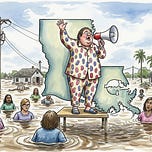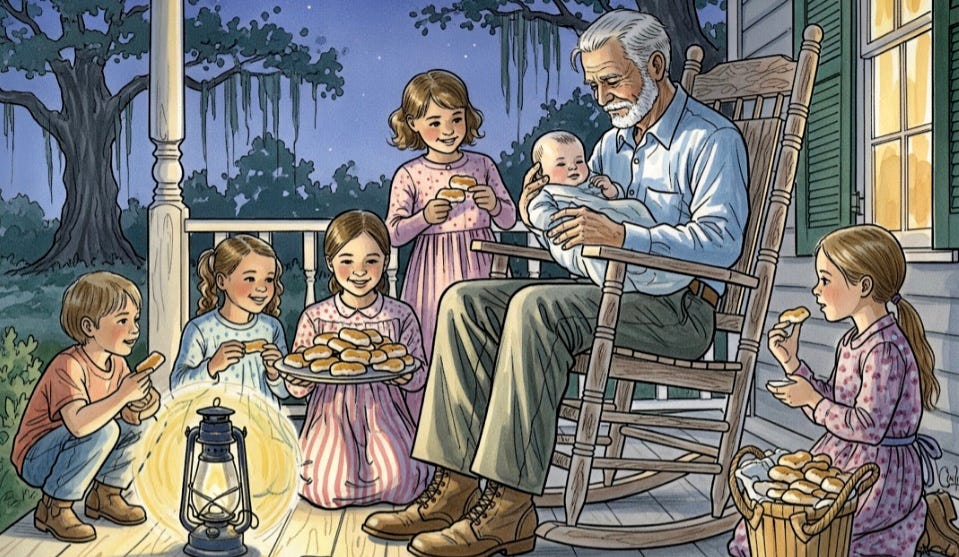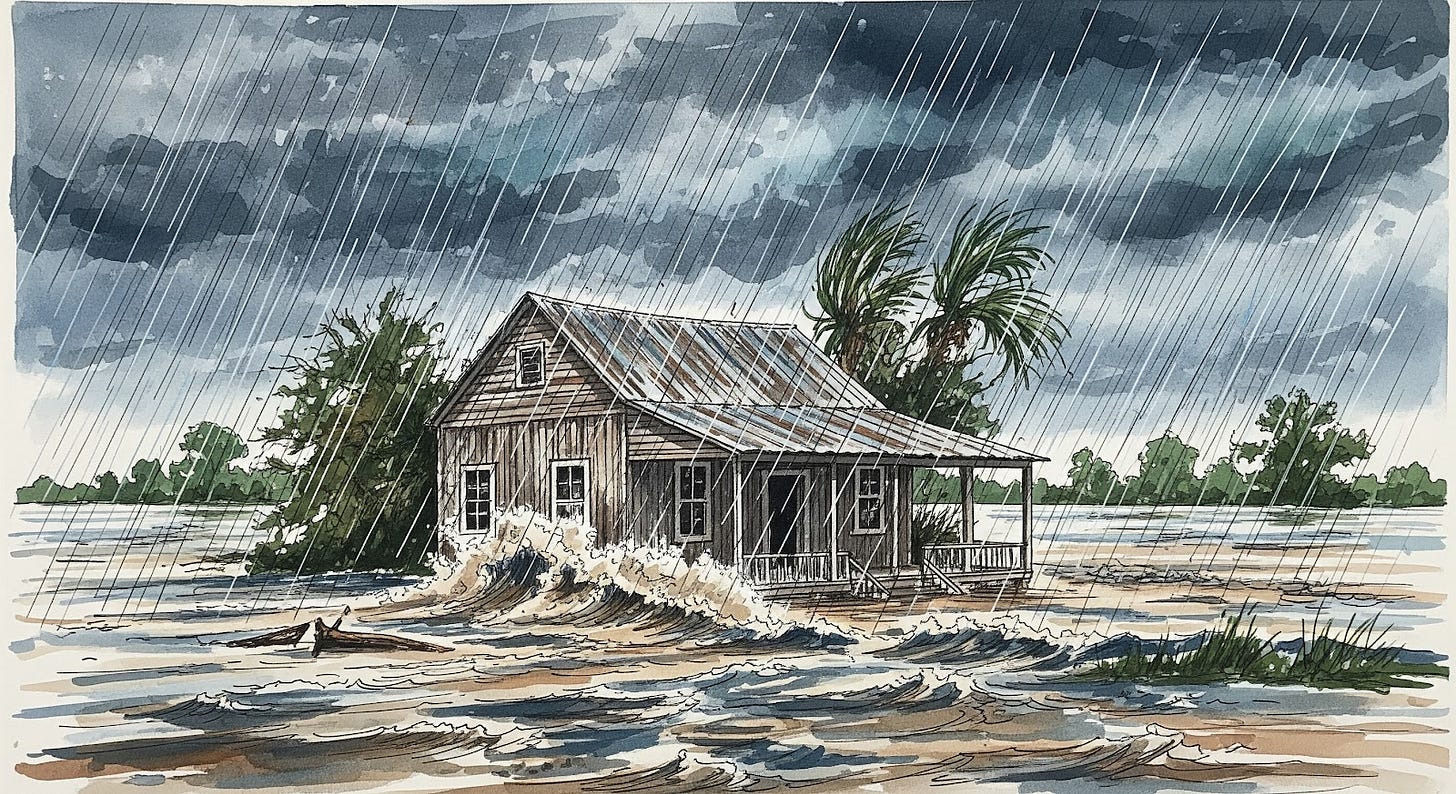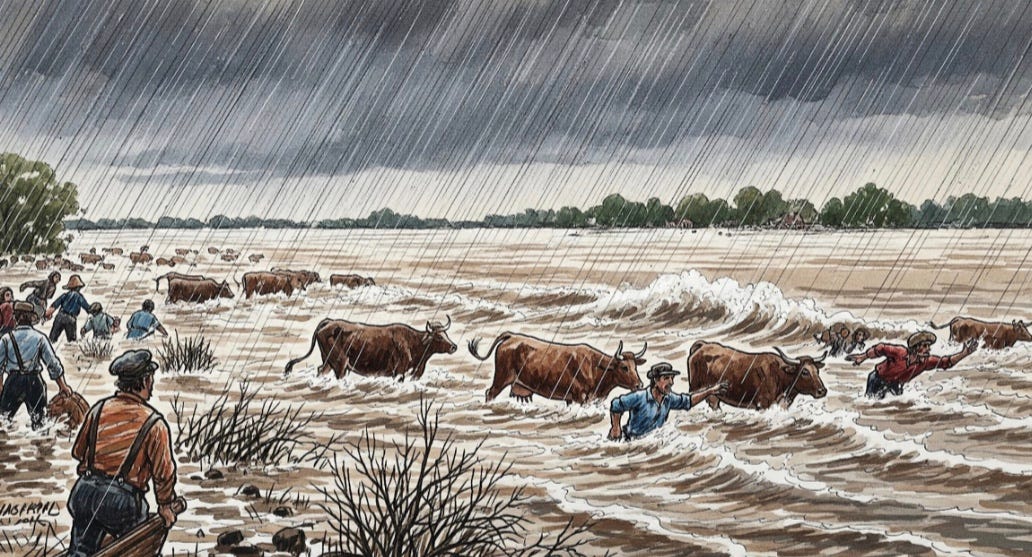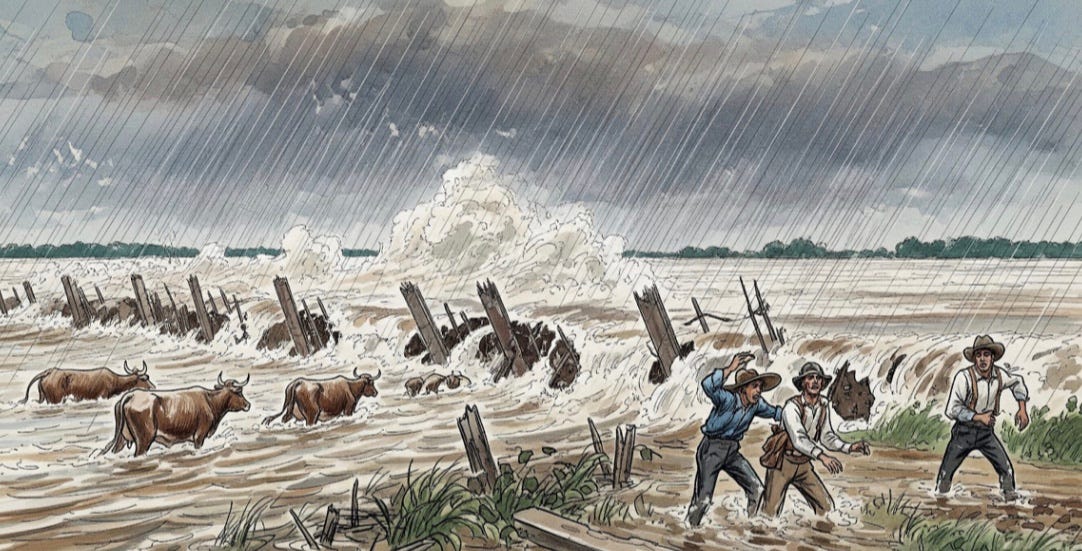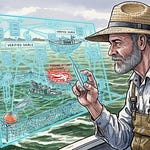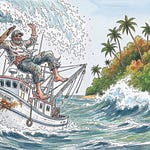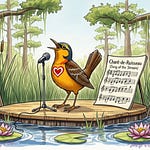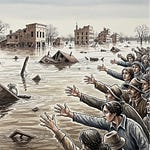CCJC Audio Podcast Episode 000103, Season 2
“Learn from the past, so you don't get stuck in the political quicksand.” – Silvere Navarre
Hello again, mes amis! Here at Cajun Chronicles Podcast Corporation, we hear you loud and clear. Some of you told us that our last tale about Ol' Kingfish Huey P. Long had you checking under your beds for politicians instead of monsters!
Well, listen here, that's just how we do things in this series. Tonight, as we continue our journey through the Great Flood of 1927, we're going to dive into the murky waters and show you what led up to the biggest gator of all, Huey Long himself, as he swam through the chaos and added his own.
Grab a beignet and find a good spot, because it's time to see how a broken levee and a whole lot of mud created a perfect political storm that crowned a Kingfish. Join us again as we tell the next part of the story.
"Huey Long was not a historical anomaly. He was a perfect storm created by a century of neglect and political failure. In Louisiana, the temptation to trade democracy for a strongman's promises is a recurring fever, and the next one is always just a bad levee or a corrupt election away." – Anonymous angry family member
Rocking the same sweet baby girl as the night before, Emile Evariste Navarre, welcomed all the young ones gathered on the porch back to hear the next part of the Great Flood of the Mississippi River in 1927.
“Ah, cher! Listen here, some of your mamas came to me and said maybe I shouldn't tell those spooky bayou ghost stories. I guess that tale I told about Ol' Kingfish Huey P. Long wasn't exactly a "sweet dreams" story, was it?” Before I tell you more about “The Rube” and his kind, you need to understand what happened.
“Well, let's try again tonight for the next part of the story. Imagine a long, long oyster shell dirt road, the kind we all know, stretching out a way. Many of us, your mères et pères, your grand-mères et grand-pères, have walked down this road before you. And Mon Dieu, did we see some things! Big ol' cottonmouths, the occasional gator sunnin' himself on the bank, even a few of those feux-folets dancing in the bayou if we were out too late.”
“The stories I'm telling you, they ain't just for fun. They're like a secret map we made just for you. We don't want you to trip over a root, get bit by a snake, or get stuck in some quicksand. Even when the story is true, as this one is, it becomes a powerful guide—a bit of wisdom passed down through time, like a family recipe for makin’ a good roux. I want you to know about the tricky parts of this road we're on, so you don't get “lost.”
That tale about Ol' Kingfish? Even if it has a little scaru and a great deal of sadness in it, is a gift from me to you. It's not meant to give you bad dreams. I want to help you be smart and brave so you can walk life's roads safely and have a wonderful adventure.”
“The whole story about the Great Flood of 1927? It ain't just about the dangers and betrayal. We all need to know about the courage to learn from what happened, so we don't make the same mistake twice.”
“Now, who's ready to hear more as we sample some of these beignets?
The 1927 Mississippi Flood: A Louisiana Story of Resilience and Betrayal
“Settling into his rocking chair, the familiar creak a comfort in the twilight, Emile brushed off a little powdered sugar off the sleeping baby’s cheek. "You're asking about the Great Flood of '27, eh? Well, let me tell you, that was a monster of a flood, but for our family, it wasn't the first time the water tried to claim our land. We were already weary from other hurricanes and floods long before then.”
"See, both the Mississippi River and Bayou Lafourche River, they’re like twins who can be both identical and fraternal. Sometimes one is calm, sometimes the other is angry. But the big winds off the Gulf, they were a different kind of monster.”
“In 1909, when I was just a young father, the wind came howling through. They called it the Grand Isle Hurricane, but we felt its eastern arm right here in Houma where we were working. It tore at our little house back in Chacahoula, like a furious gator, and we prayed to keep the roof over our heads. It was a terrible wind, but that time we mended our homes and our spirits."
"Then came the 1918 storm. That one, she went west, they said, right through Lafayette. Your Tante Julienne was living there then. She said the city was a mess, with trees snapped like sugarcane stalks. Travel was impossible, and it felt like the world had stopped. That became a different kind of worry, not just for our own homes, but for family we couldn't reach. We never did find some friends and family members. The land had to heal from that one, and so did we."
"Only two years later, in 1920, another hurricane came calling, right on our doorstep near Houma. It brought so much wind and so much rain. It hit the sugar cane crops hard. You children know how important that cane is to us. We worked so hard to grow it, and that storm just laid it flat. We were tired of the constant battle with the wind and the rain, always rebuilding, always replanting."
"Then the last one, the 1926 storm, that today would be called a Category 3 hurricane, a fierce one. It made landfall near Houma, and the water? Oh, the water was a beast. A storm surge of 15 feet in Terrebonne Parish! Our home in Chacahoula was knocked off its pilings. The graves across St. Lawrence Church? Some of them were floating!”
“It was like the Gulf itself was trying to swallow us whole. We lost almost all our sugar cane that year, nearly 90%. Our cattle drowned or disappeared. It was a heartbreaking sight. After that, we were exhausted. We thought, 'Surely, the worst is behind us.'"
"But oh no. What the winds couldn't do, the endless rain did. The Great Flood of '27 wasn't from a single storm, but from so many storms that filled the Mississippi River up north. All that water came rushing down, a slow-moving, unstoppable force. We had already been fighting the water for years, getting stronger each time, but also growing so, so tired.”
When that levees and canals broke, we were already weary, but we did what our people always do. We helped each other, we stayed strong, and some rebuilt. But for our family we lost too much. It was time to move on to the American West where your Noncle Claude was working for the Southern Pacific Railroad in Arizona.”
The Great Flood of 1927 broke us. It's part of our story because above all, the flood and what happened afterwards to poor folks like us under the leadership of Huey P. Long is history worth knowing and sharing. It wasn’t just where we learned to respect the water, my children, because we've known its power for a very long time. It was life lessons far deeper.”
Back To The Day The Mississippi River Broke Free
“Mais, cher! Let me now tell you about the Great Flood of 1927. It was an event about something natural and something man-made getting all mixed up together, like a fine roux with too many spices in a pan too small.”
“It started with nature. Way up north, it rained for months and months, and all that rain had nowhere to go. It ran down into the Mississippi River, making it swell up big and powerful. At the same time, the snow from the winter was melting, adding even more water to the river. The river just got bigger and bigger, like a hungry gator on a rampage.”
“Now, here's where the man-made part comes in. People had built these big dirt walls and canals called levees to keep the river from flooding the land. Everyone thought they were strong enough. But the river in 1927 was too much. The pressure of all that water was just too strong, and the levees and canals broke in a lot of places. The water rushed out everywhere, covering more than 20,418,774 square arpents of land.”
Cajun Chronicles Notes: Mais, cher, imagine this. An arpent is a piece of land a little smaller than a schoolyard or a big field where you play football, but without the end zones. It's the perfect size for a good garden, maybe a house, and a little patch of land for some chickens to run around. It's just a nice piece of land, big enough to take care of a family.
“The flooding started to get really bad in April, just when the weather was getting warm. Many, many people had to leave their homes with nothing but the clothes on their backs. It was a sad, sad time. It’s hard to say how many people and animals lost their lives. In Louisiana alone, over 60,000 people were forced to move to higher ground, living in tents and shelters.
“The flood taught us a hard lesson: we can build things, but we always have to respect the power of nature. It also taught us about both the kindness of those heroes and heroines who genuinely are there to help us. But also altered our lives forever by those like Huey P. Long who were more than happy to use our troubles to their advantage. Nothing would ever be the same!”
Ruin After the Rain: The Flood of '27
“After the great flood of '27, Bayou Lafourche was a mess and so were our people. The crooked politicians and land speculators, they were like the alligator lurkin' just under the muddy water. They'd hide their true intentions behind a smile and a promise of help that never came, waiting for the moment we were at our weakest, with our homes washed away and our crops ruined.”
“They'd come with their "help," offering to buy our land for next to nothing or trapping us in deals we couldn't escape, their grip as strong and unforgiving as an alligator's jaw. They took advantage of the poor sharecroppers, fur trappers, and landowners, leaving them with nothing but empty pockets and broken promises. Just like that old reptile Jean Amable, they were a patient and constant threat, always there in the murky depths of our misfortune. Huey P. Long was the worst of all!” He’s the scary story I want you to remember.”
The Alligator and the Flood
“Eh, you say you wanna hear more about Huey P. Long and that '27 flood, oui? Well, let me tell you, that man, he wasn't governor yet. He was just the boss of the Public Service Commission, a big job, but not the biggest. But he was already a firebrand, you know? Claimed to be a true man of the people, always talkin' about how the little guy was gettin' pushed around by the bigwigs. He was already fixin' to run for governor again in '28.”
“Then the flood waters came. Not just a little bit, but a whole lotta water, a disaster that covered half the state. The rich folks in New Orleans, they saw it comin' first and they just went and dynamited the levees and canals downriver to save their fancy city.”
“They didn't care that they were drowning the folks down our way, the poor farmers and sharecroppers. And Governor Simpson and his pals? They didn't do much of nothin' to help. The Red Cross and churches and all them others? Sorta helped but not like you’d think. (Another story for another time). Let’s just say they were helping hands, but maybe not the heroes who knew what they were doing. But the local politicians, including Huey, were seen by many as useless, or worse, just plain crooked.”
“Huey, he saw this as his big chance. He stood on those mud-soaked oyster shell dirt roads and pointed his finger at the whole mess. He’’d shout, waving his arms in the air like a whirlwind . . . ‘They done sacrificed y'all to save their own skin!" he'd yell. ‘They done put a crown on the wrong head!’"
“He told everyone, "Every Man a King!" And the people, they believed him. They were angry, they were hurt, and they were tired of bein' used. That flood wasn't just water. It was the fuel for a fire, and Huey, he was the match.”
“He rode that flood of anger all the way to the governor's mansion, and it changed everything, not just for Louisiana, but for the whole country. That '27 flood, she washed away more than just land; she washed away an entire political era and not always in a good way.”
“Tomorrow nite, I’ll tell you what he done, so you won’t be tricked into believe the government or elect men like Huey ever again!”
—------
This whole story, my beloveds, is like the old fishing net we use to catch shrimp. Our family, we've been mending this net for a long, long time. Every hurricane and every flood tore a new hole. Yet, we kept on patching it up to make sure we could still catch enough to live.
But then came the Great Flood of '27 and that was like pulling up the biggest, ugliest gator you ever saw. That Huey Long? He was that gator—he got tangled in our net and nearly tore it to pieces, even though all we wanted was to catch a few fish. I'm telling you this so you'll know how to mend your own net when life gets rough.
More importantly, so you'll know exactly what to do when some politician tries to jump into your catch and take it all for themselves. Be sure to join us again for Part 3 of this series, where we see what happens next with that gator in our net.
If you missed Part I of this series, go back! The Flood, The Kingfish, and the Birth of a Demogogue
A Word of Wisdom:
Our fictional and non-fictional tales are inspired by real Louisiana and New Orleans history, but some details may have been spiced up for a good story. While we've respected the truth, a bit of creative license could have been used. Please note that all characters may be based on real people, but their identities in some cases have been Avatar masked for privacy. Others are fictional characters with connections to Louisiana.
As you read, remember history and real life is a complex mix of joy, sorrow, triumph, and tragedy. While we may have (or not) added a bit of fiction, the core message remains, the human spirit's power to endure, adapt, and overcome.
© Jerilee Wei 2025 All Rights Reserved. Cajun Chronicles Audio Podcast - Bringing you the heart of Louisiana. Artwork generated with Google Docs Image Maker

